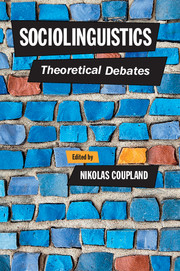Book contents
- Frontmatter
- Contents
- List of contributors
- Preface and acknowledgements
- 1 Introduction: Sociolinguistic theory and the practice of sociolinguistics
- Part I Theorising social meaning
- Part II Language, markets and materiality
- Part III Sociolinguistics, place and mobility
- Part IV Power, mediation and critical sociolinguistics
- Part V Sociolinguistics, contexts and impact
- 15 Are there zombies in language policy? Theoretical interventions and the continued vitality of (apparently) defunct concepts
- 16 Quantitative sociolinguistics and sign languages: Implications for sociolinguistic theory
- 17 Theorising language in sociolinguistics and the law: (How) can sociolinguistics have an impact on inequality in the criminal justice process?
- Part VI The evolution of sociolinguistic theory
- Index
- References
16 - Quantitative sociolinguistics and sign languages: Implications for sociolinguistic theory
from Part V - Sociolinguistics, contexts and impact
Published online by Cambridge University Press: 05 June 2016
- Frontmatter
- Contents
- List of contributors
- Preface and acknowledgements
- 1 Introduction: Sociolinguistic theory and the practice of sociolinguistics
- Part I Theorising social meaning
- Part II Language, markets and materiality
- Part III Sociolinguistics, place and mobility
- Part IV Power, mediation and critical sociolinguistics
- Part V Sociolinguistics, contexts and impact
- 15 Are there zombies in language policy? Theoretical interventions and the continued vitality of (apparently) defunct concepts
- 16 Quantitative sociolinguistics and sign languages: Implications for sociolinguistic theory
- 17 Theorising language in sociolinguistics and the law: (How) can sociolinguistics have an impact on inequality in the criminal justice process?
- Part VI The evolution of sociolinguistic theory
- Index
- References
Summary
Introduction
Quantitative sociolinguistics has been part of the language research landscape since the early 1960s, beginning with the work of William Labov in New York and Martha's Vineyard (Labov 1969; 1972a,b). In an early and often-cited study on the raising and centralization of vowels on Martha's Vineyard, Labov (1972b) found that centralization corresponded with certain age groups and with the speaker's orientation towards traditional life on the island. These findings represented one of the earliest uses of quantitative methods for arriving at conclusions about the structure and use of language. The results showed that linguistic variation is not random, that it is quantifiable, and that understanding variation is essential to understanding how language works. Numerous studies in the variationist tradition established by Labov have taught us a great deal about language structure and language change. This chapter focuses on what quantitative sociolinguistics has taught us about variation in sign languages and the implications of that knowledge for sociolinguistic theory and for linguistic theory more generally.
In contrast to the study of variation in spoken languages, the study of variation in sign languages is still in the relatively early stages. The first large-scale study of variation in American Sign Language (ASL) appeared only in 2001 (Lucas et al. 2001b). That study, based on data collected in the mid-1990s in seven areas of the United States, was following by similar studies in Australia and New Zealand (Schembri et al. 2009; McKee et al. 2011), the United Kingdom (Schembri et al. 2013), and Italy (Cardinaletti et al. 2011; Geraci et al. 2011; 2015), as well as by a study of Black ASL, the variety of ASL that developed in the segregated schools of the U.S. South before the civil rights era of the 1960s (McCaskill et al. 2011). Although we have ethnographically oriented studies of smaller signing communities, such as Green's (2014) work on Nepali Sign Language, as well as earlier work involving individuals or small groups of signers (see Patrick and Metzger 1996 for a review), large-scale surveys in several countries have provided the primary insights into the relationship between variation in sign languages and sociolinguistic (and linguistic) theory. We are fully aware of the advantages of recent trends in sociolinguistics that have combined close ethnographic observation with quantitative methods and sometimes focused on marginal members (e.g. Bucholtz 1999; Eckert 2000).
- Type
- Chapter
- Information
- SociolinguisticsTheoretical Debates, pp. 349 - 366Publisher: Cambridge University PressPrint publication year: 2016
References
- 2
- Cited by



